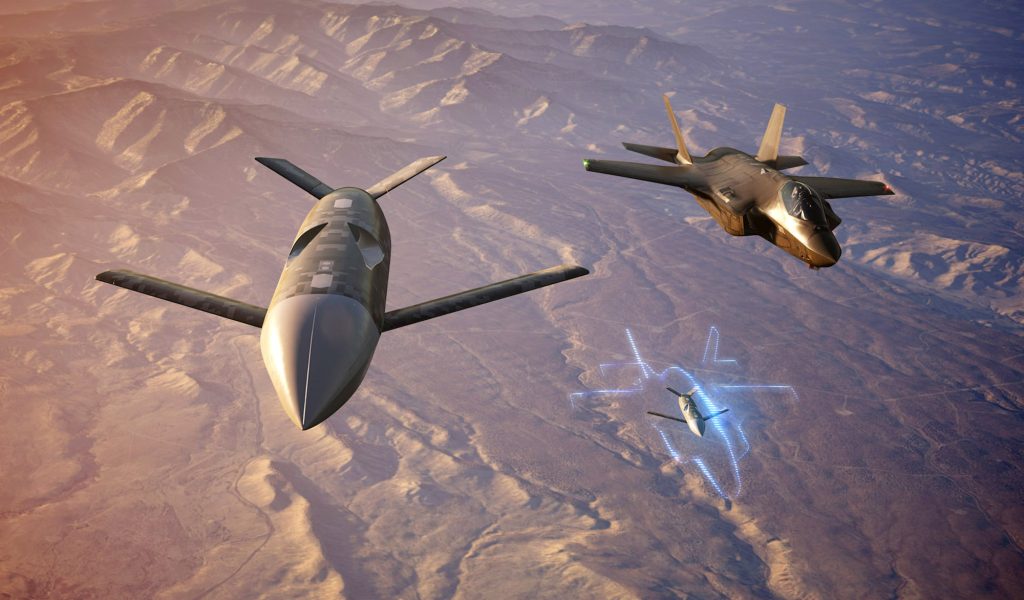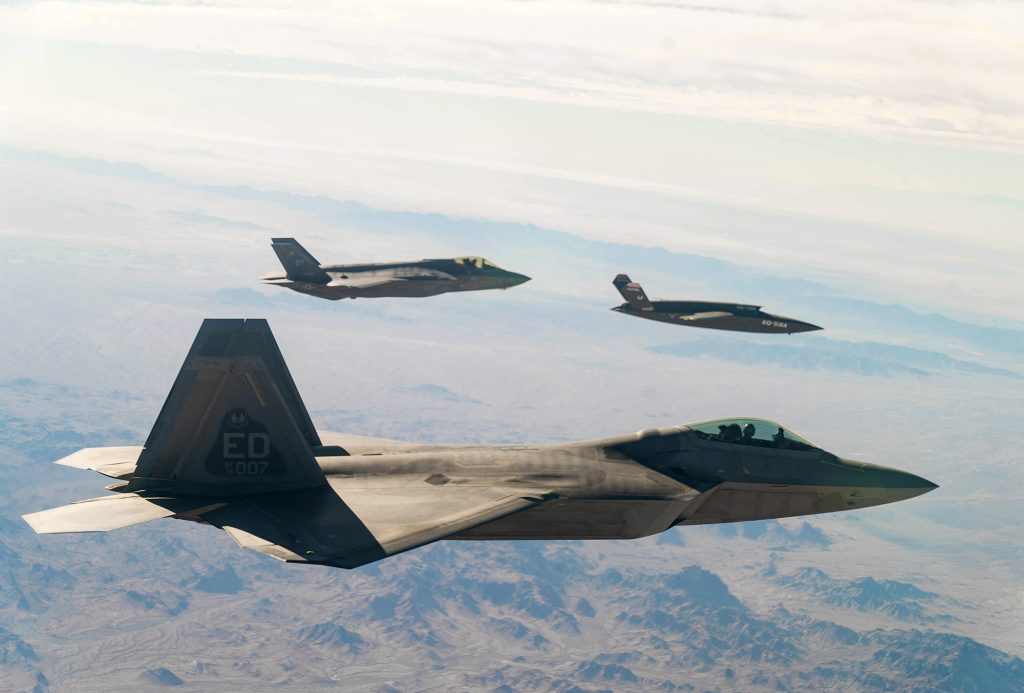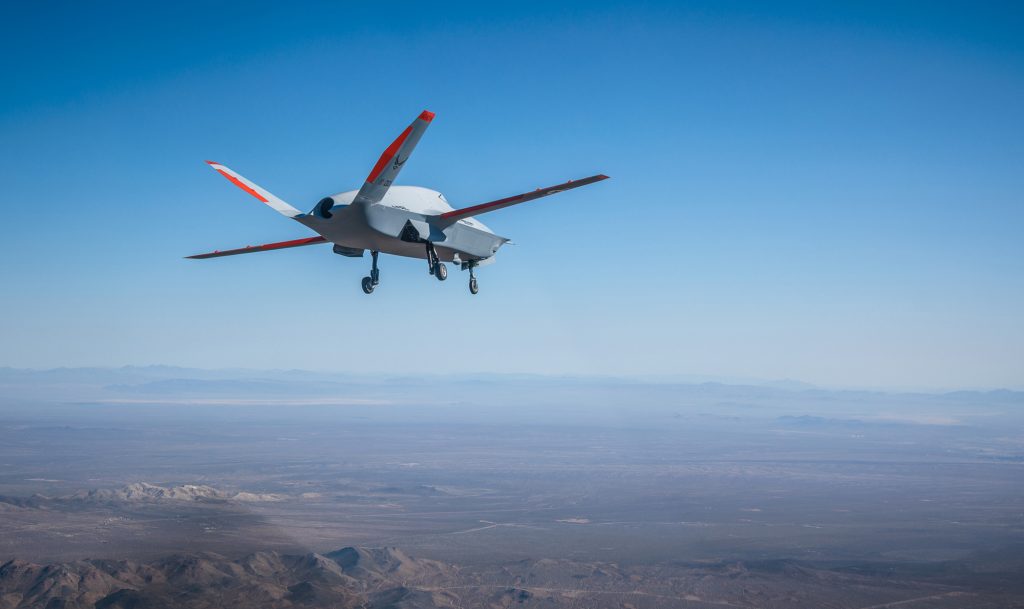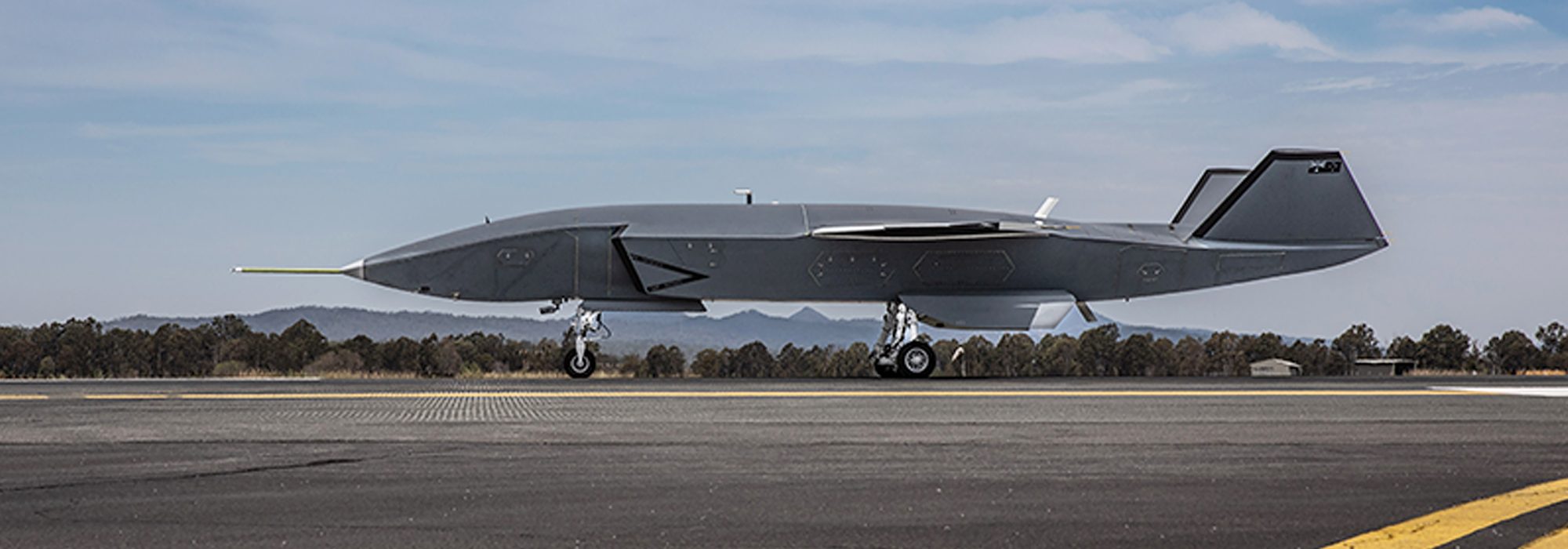USAF launches its most ambitious new aircraft program in a generation. Can Collaborative Combat Aircraft tilt the numbers game in America’s favor?
The ambitious goal: Initial operational capability in as little as five years.
Air Force leaders think that’s possible because production-representative prototypes already have flown, and because the urgency to field combat mass is intensifying as China gets closer to its stated goal of having the military capability to take Taiwan by force in 2027.
To counter China’s growing military might, the USAF envisions acquiring at least 1,000 and possibly up to 2,000 CCA by the mid-2030s. That would make the autonomous combat jets among its most numerous assets. By contrast, the Air Force has only a little more than 400 F-35s today out of a total planned buy of 1,763—a number it can’t achieve at present acquisition rates before 2040.
If their promise bears out, CCA could restore the Air Force’s combat mass—eroded by overuse and slower-than-anticipated acquisition over the past two decades. It could also stimulate a host of new entrants into the service’s industrial base.
Secretary of the Air Force Frank KendallWe can never afford” … enough crewed combat airplanes to sustain a numerical edge [over China].
Secretary Frank Kendall and other senior Air Force leaders outlined their CCA plans at the 2024 AFA Warfare Symposium in Aurora, Colo., in February. They declared there’s “no time to lose” in fielding these new assets. More mass is needed to counter the growing numbers and capability of China’s air arms and counter-air capabilities, as well as those of other potential adversaries. USAF’s combat fleet is the smallest and oldest in its 77-year history. The U.S. can’t win a numbers contest against China’s military, which can build equipment at practically whatever rate it wants, with no Congress or free press to answer to.
“We can never afford” enough crewed combat airplanes to sustain a numerical edge, Kendall said.
Uncrewed, autonomous aircraft can be cheaper to build and operate than those with pilots on board because they don’t need life support, control devices, or escape systems. Those add up to more weight, and weight adds cost. A pilot also imposes performance limits: While an uncrewed aircraft can easily take a 10-plus-G turn, a human pilot generally can’t.
By contrast to an F-35A, costing $80 million to $100 million apiece, each CCA is targeted to cost only about 25 to 30 percent as much. That’s still about $30 million per aircraft, but a huge savings overall, especially when purchased in volume. CCA will generally cost too much for many one-way missions—although service leaders say that will be up to the tactical commander to decide—but compared to a crewed fighter, they’ll be a bargain.
FAST PACE
The contracts awarded this spring will be for a basic “Increment 1” CCA with sensor, targeting, and munition systems similar to those on crewed fighters and bombers. CCA missions could include jamming, suppression of enemy air defenses, and as decoys to “soak up” enemy missiles and enable crewed fighters and bombers to reach their targets.
“Increment 2” CCA will follow next year, with the aim of greater stealth and autonomy.
Maj. Gen. R. Scott Jobe, director of force design, integration, and wargaming and deputy chief of staff for Air Force Futures said Increment 2 capabilities, cost, and relative sophistication will depend on what industry offers in the coming year. While a high-end, “exquisite” platform could result, so might an inexpensive solution oriented around a single mission, Jobe said, adding, “nothing has been ruled out.”
It’s possible two distinct solutions could emerge from this stage, one high end, the other more basic.
Andrew Hunter, assistant secretary of the Air Force for acquisition, technology, and logistics, said Increment 2 could have “a very different set of requirements” compared to Increment 1. He said the Air Force is coordinating its development with the Navy, Marine Corps, and foreign partners, and that those wider partnerships could yield a future “Increment 3.”

Progress thus far has been rapid. Brig. Gen. Jason D. Voorheis, program executive officer for fighters and advanced aircraft, credited the close collaboration among Air Combat Command, the Air Force Research Laboratory, Air Force Materiel Command, and industry with shortening the development cycle.
“They’ve … developed market research, they’ve done operational analysis,” he said. “They’ve done concept refinement, defined operational attributes, got an acquisition strategy approved, and then went on contract for building production-representative test articles in under two years, which is a pretty phenomenal pace.”
This “extreme partnership will be the norm going forward,” he predicted, especially after the formation of the Air Force’s new Integrated Capabilities Command, announced during the AFA Warfare Symposium in February.
“Government-owned open architectures for both mission systems and autonomy” will be crucial to these systems, Voorheis said. That central ownership of the common elements will free the Air Force from historical “prime and sub-vendor lock,” where the initial contract fixes a single supplier of all future revision and upgrade contracts. Without proprietary intellectual property, competition can continue with each successive increment, enabling future upgrades from a host of competitors.
These architectures “enable rapid technology insertion and rapid fielding of software-defined, platform-agnostic capabilities over time,” Voorheis said. The CCA ecosystem is already extensive, with more than 30 industry participants involved in “autonomy, air vehicles, mission systems, and software development.” Continued competition can keep those players in the game, and potentially attract new entrants in the future.
Hunter said digital design and modeling are making it possible to understand “daily” the evolving configurations and options, and he suggested that choosing winners should be comparatively obvious when the time comes.
“We … have really gotten [that] right,” he said.
In place of the conventional, rigid requirements process, Hunter described how CCA development is fueling “continuous daily engagement” among the government and its vendors. By the time the competition reaches the endgame, Hunter said, industry will not be guessing what the government wants, and the government will have a clearer understanding of which vendors best deliver on the goal.
TEAM EFFORT
A “slew” of contractors are developing the software that will fly the CCA, building off of the Air Force Research Laboratory’s Skyborg program, the “foundational architecture” for a standardized autonomous flying algorithm.
Companies in the running for Increment 1 are Anduril, Boeing, General Atomics, Lockheed Martin, and Northrop Grumman. Those not picked, such as Kratos, which had been a key player in earlier development, will be able to compete later, in Increment 2, or after. Kratos has said it plans to compete for Increment 2.
“Don’t read too much into that short list,” an Air Force official said. “We are not ignoring any expertise that is out there.”
All the Increment 1 competitors have done extensive work on both remotely piloted and autonomous aircraft, and on manned-unmanned teaming of aircraft systems.
“We’re going to go to at least two” designs for the next stage of development, Kendall told reporters at the conference. “Our preference” is to carry three contractors into the next phase, he said, but that will be “difficult, because of the level of funding we have in the budget.”

Whether more players stay in the game could depend on how much they might be willing to share in the cost of development.The Air Force wants to preserve competition on CCA for as long as possible, to keep contractors focused on innovation, fresh ideas, and driving costs down.
Even after the competitive development phase, though, Kendall revealed that the Air Force could, if funding permits, greenlight two Increment 1 designs for production.
“How many we will carry into production is uncertain,” he said. “We will definitely do one.” That contract is targeted for 2026. There’s “a possibility we could do more,” he added, indicating the service is “working out some way to do that.”
Increment 2 could involve international partners, Kendall said. Boeing is expected to offer its MQ-28 Ghost Bat, developed under contract with Australia, for Increment 1 and/or Increment 2. Though Kendall didn’t identify allies that might participate in CCA, any that do will be among “our closest partners.”
AUTONOMY
Hunter said the technology demonstrated so far provides “a high degree of confidence that we can deliver a useful degree of autonomy” in the first increment, but not as much, perhaps, as originally hoped for.
The Air Force wants hardware it can deliver into the hands of operators as quickly as possible, Kendall said, indicating he anticipates doing so in 2028.
To further expedite delivery, Air Force Chief of Staff Gen. David W. Allvin said questions about development, basing, and training are all being addressedconcurrently, and experimentation with surrogate aircraft and platforms is happening now to “shape how we would use” and integrate CCA when they join the force.
AFA’s Mitchell Institute for Aerospace Studies concluded, after a series of wargames last year, that large numbers of more basic, less-costly CCAs would yield a greater impact than fewer, high-end systems in a battle against China.
The wargames, which included Active-duty operators and others, found that rather than using CCA as uncrewed “escorts” for manned aircraft, they could instead be sent out on their own to tackle missions independently. They could also operate semi-independently, taking off from their own location to meet up with crewed aircraft for one phase of a mission, then continue on their own afterward, or potentially cover the escape of crewed aircraft heading back to base.
Concerns that fighter pilots could be task-saturated managing CCAs in addition to their primary mission proved unfounded, Jobe said. F-22 pilots in such experiments demonstrated they can comfortably manage “up to six” CCAs without interfering with their other tasks.
Robert Winkler, Kratos vice president of corporate development for national security, said the Mitchell wargames showed CCA would have the greatest impact operating “inside the first island chain,” a reference to the first string of islands off the coast of mainland China. Spreading them out in that region gave “the enemy a much harder targeting solution,” operating from austere locations “or being air-launched.”
Introducing CCAs “completely trashed, for lack of a better term, the enemy’s scheme of maneuver and strategy,” Winkler said. “It disrupted their ability to do [defensive counter-air]. It disrupted their pulsed operations, and it made our … operations … an order of magnitude more effective. It made manned aircraft more survivable and unmanned aircraft more survivable, and it reduced the overall tanker requirements.”
In fact, CCAs “proved out” the Agile Combat Employment model, he said.
But the notion that CCAs might be expendable has not been borne out so far. Jobe said CCAs could be used on one-way missions if the target is considered important enough, but that the plan is not to do so routinely. Once thought of as platforms that would not be sustained long-term, it now appears they will require maintenance, even if some remain crated up—possibly pre-positioned at forward bases—until needed.
Jobe said CCA “really changes … our capability, our resourcing, … and our topline investment.”
Because of that, it can reduce the incremental cost of gaining new capabilities, he noted. “It’s really disruptive over multiple areas.”
CCAs also present “a lot of dilemmas to the adversary or potential adversaries,” he said. With them in the mix, the scheme of maneuver will change, and the enemy will have to adapt. “It presents a lot of options,” Jobe said, for things “we just haven’t been able to do before because of the … risk levels and force packaging that we would have had to do in the past.”
David Alexander, president of General Atomics Aeronautical Systems, said industry offerings for Increment 1 will likely wind up looking similar and having comparable capabilities. Speaking on the Mitchell Institute’s “Aerospace Advantage” podcast, he praised the clarity of the Air Force’s vision.
“There’s definitely a crystal-clear mission, crystal-clear requirements,” he said. “And I can’t speak for the other four [competitors] but physics is going to drive us all into something very similar. I think when [the Air Force] gives you a range … an altitude and … a speed and so on, that requires airframes to be designed for those; what we would call a ‘point design.’ And to meet that point design, … I would expect them to be very similar … across the five.”
The companies are all working to “the same requirements,” Alexander said, but there is room for “interpretation.” As a result, “some slightly different offerings, perhaps in the systems, sensors, and payloads” are possible. But “airframe-wise” the overall mission “is the same for all.”
COST-EFFECTIVENESS
General Atomics was picked in February by Air Force Research Laboratory to design and build the Off-Board Sensing Station (OBSS) aircraft, which will explore data-sharing technologies hosted on an autonomous drone. Given an “X-plane” designation—the XQ-67A—the aircraft made its first flight in late February. General Atomics beat Kratos for the work, after both developed platforms all the way through a critical design review.
The program is one of several efforts in AFRL’s Autonomous Collaborative Enabling Technologies program.
Winkler said CCAs will need new, smaller, and lower-cost weapons and sensors optimized for them, or to rely on off-board systems. If the Air Force wants a “reasonably costed” CCA system, “we can’t go with exquisite sensors” such as those now deployed on fighters and bombers. “We have to figure out how to bring the sensor cost down.”
That approach must be applied across the board to hold costs down. Otherwise, he added, “if you try to build a CCA like a manned aircraft, it’s going to cost like a manned aircraft.”

This approach will flow through all the subcontractors, including the engine makers. Mark Rettig, vice president and general manager of business development at GE Aerospace’s “Edison Works,” said his company is investing “heavily” in new classes of engines specific to CCA applications.
“We’re partnered with another low-cost provider to give us a comprehensive team to address the needs of these platforms,” he said, but did not disclose the name of the partner company.
Tom Jones, Northrop Grumman’s aeronautics sector president, said there are “two different time scales” for the CCA: first to get the technology to operators so they can “start to experiment with it and understand what the technology brings,” and second, scaling up to high-rate production.
That means reusing “as much technology as you can,” Jones said. As a result, he added, “I view this as an integration program rather than a development program.”
Northrop built the first B-21 bomber on production tooling, having worked out the bugs before production began, Jones remarked, and Northrop aims to follow a similar approach to the CCA.
By using digital engineering, participants can “burn down risk, … iterate significantly faster,” and avoid the pitfall of building bespoke one-offs and then having to think about manufacturing as an add-on at the end.
“We have much more opportunity to bring in manufacturing engineers, bring in logistics people and make sure we get those things baked in, which means a smoother transition into production,” according to Jones. That makes the Air Force’s timetable “doable.”
Once deployed, Alexander said CCAs must be designed to operate with fewer people and to require less scheduled maintenance.
Cost and time will be saved, he said, by keeping “that focus on production.”
